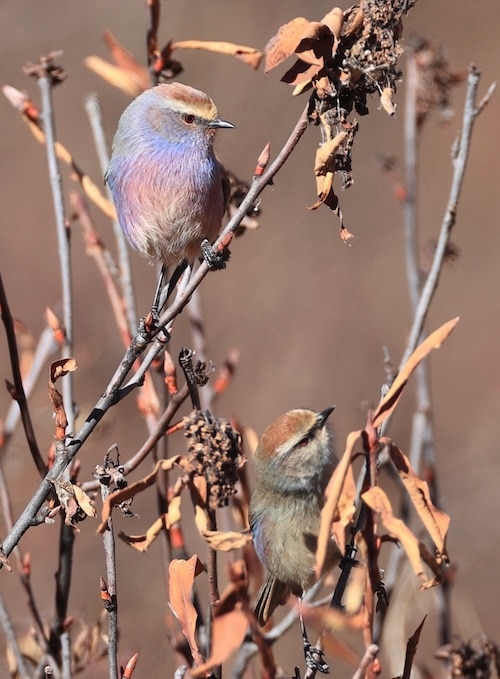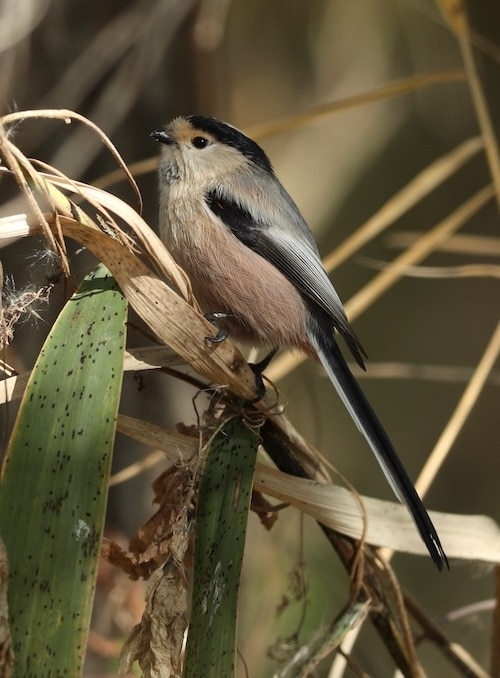Aegithalidae – Tit-warblers, Bush Tits & Long-tailed Tit
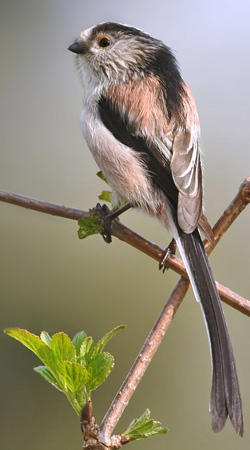
The Aegithalidae (Bushtits, Tit-warblers & Long-tailed Tit), are a family of small, (mostly) drab passerine birds with moderately long tails. The family contains 11 species in three genera, all but one of which are found in Eurasia (the other is in North America). Bushtits are active birds, moving almost constantly while they forage for insects in shrubs and trees. During non-breeding season, birds live in flocks of up to 50 individuals. Several bushtit species display cooperative breeding behaviour, also called helpers at the nest. The family is part of the sylvioid radiation of oscine passerines. In the past, they have been placed with the tits and chickadees and penduline-tits within a more inclusive Paridae. However, molecular phylogenetic studies now show that Aegithalidae and Paridae are only distantly related within Sylvioidea. Aegithalidae forms a well-supported clade with Phylloscopidae and Scotocercidae. Aegithalidae is most likely sister to Scotocercidae.
All the Aegithalidae are forest birds, particularly forest edge and understory habitats. The species in the genus Aegithalos prefer deciduous or mixed deciduous forests, while the tiny Pygmy Tit is found mostly in montane coniferous forest. The Bushtit is found in a wide range of habitats, including on occasion sagebrush and other arid shrublands, but is most common in mixed woodland. Most species in this family live in mountainous habitats in and around the Himalayas, and all are distributed in Eurasia except the American Bushtit, which is native to western North America. The Long-tailed Tit has the most widespread distribution of any species of Aegithalidae, occurring across Eurasia from Britain to Japan. One species, the Pygmy Bushtit, is restricted to the mountains of western Java.
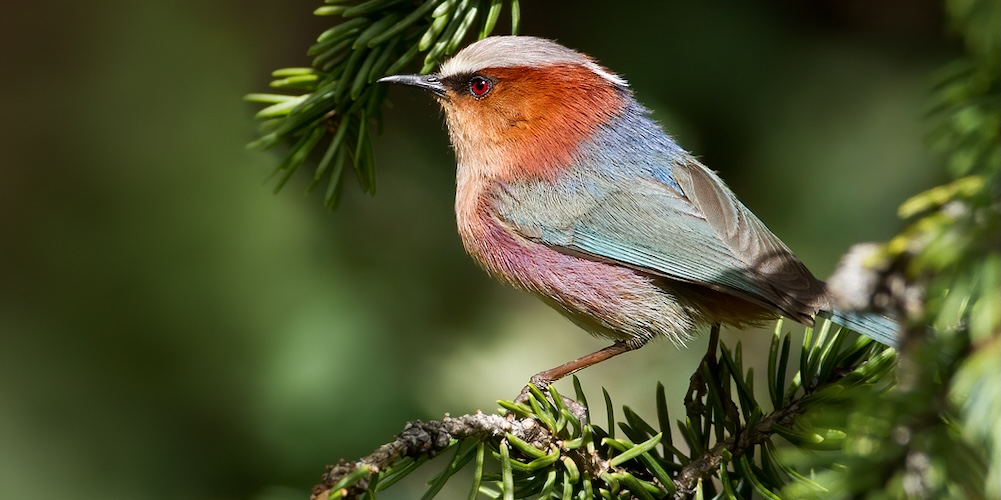
Crested Tit-warbler Leptopoecile elegans – ©Dubi Shapiro
The species in this family are generally not migratory, although the long-tailed tit is prone to dispersing in the northern edges of its range (particularly in Siberia). Many mountainous species move to lower ground during the winter.
They are omnivorous, primarily eating insects and other invertebrates such as leafhoppers, treehoppers, aphids, scale insects, and caterpillars. Plant material, such as berries or seeds, is taken occasionally during the winter. The family generally forages arboreally, usually in the shrub layer or canopy, and seldom visits the ground. Prey is generally gleaned from branches, leaves and buds. Less frequently, prey is taken in the air. While foraging, this agile family may hang upside down on branches (although this behaviour is not thought to occur in the tit-warblers) and even manipulate branches and leaves in order to locate hidden food.
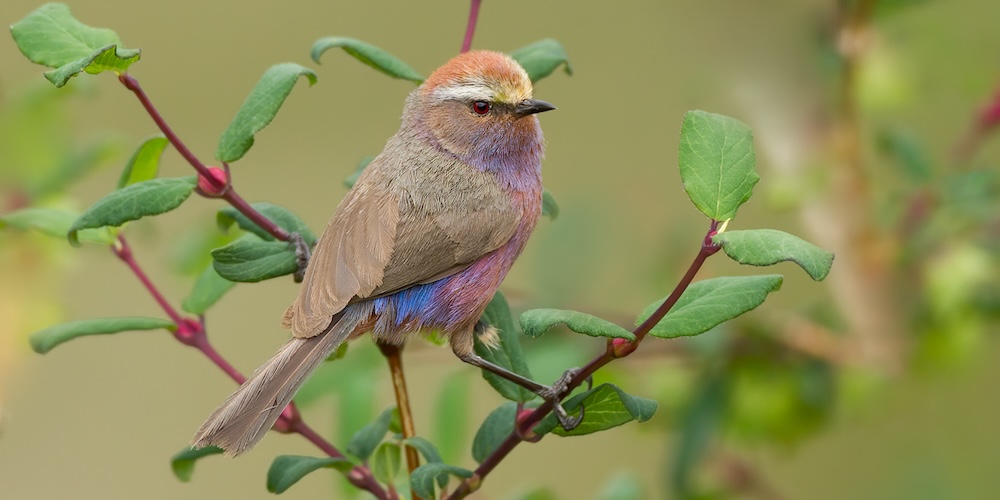
White-browed Tit-warbler Leptopoecile sophiae – ©Dubi Shapiro
They live in flocks ranging from four to fifty individuals. Flocks form as soon as one breeding season finishes and last until the next one begins. Long-tailed Tits have large broods and after fledging the parents and chicks will form a flock of a dozen or more. They maintain contact with sibilant or tinkling calls; their songs are quiet. Other species of birds, such as tits or warblers, will occasionally joining the flock to forage.
|
|
|
|
White-browed Tit-warbler Leptopoecile sophiae |
Silver-throated Bushtit Aegithalos glaucogularis |
|
©Nick Ludovic Green – Bird-Photo-Tours ASIA |
|
The family generally has a monogamous breeding system. Pairs may be aided by helpers, where a related individual (or more than one) helps the established pair raise the young. This has been recorded in at least four of the species; further research is required to see if the behaviour carries over to other members of the family.
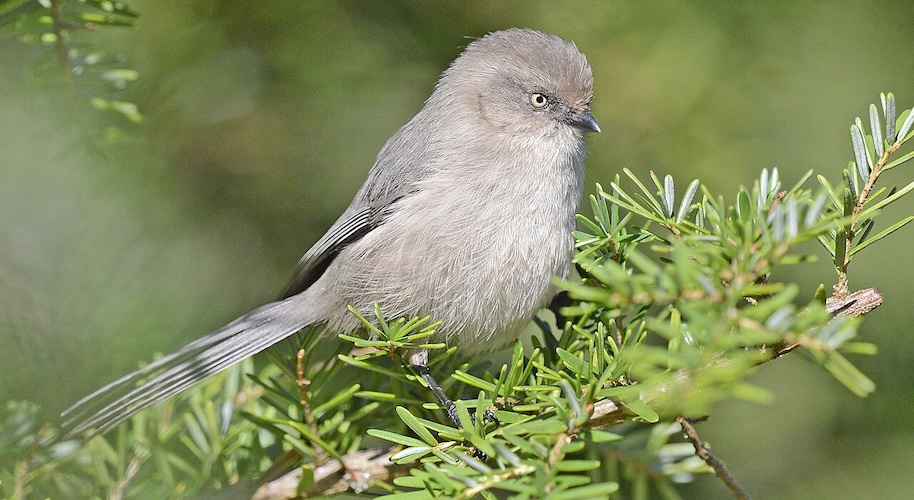
American Bushtit Psaltriparus minimus – ©VJAnderson, CC BY-SA 4.0 via Wikimedia Commons
Aegithalids make domed, bag-like, nests of woven cobwebs and lichen, which they line with feathers. They make the nests in trees with thick foliage, making them difficult for predators to find. The clutch generally comprises six to ten white eggs, which in many of the species have red speckles. Adults incubate the eggs for about two weeks; young stay in the nest for about sixteen or seventeen days. In at least four of the species (Long-tailed Tit, American Bushtit, Black-throated Bushtit and Silver-throated Bushtit), only the female incubates. Young chicks are fed exclusively on insects and spiders.
-
Number of bird species: 11
(As at October 2025)
According to the recently (2025) amalgamated AviList, there are eleven species, in three genera in the Aegithalidae family. They are:
Crested Tit-warbler Leptopoecile elegans
White-browed Tit-warbler Leptopoecile sophiae
American Bushtit Psaltriparus minimus
Long-tailed Tit Aegithalos caudatus
Silver-throated Bushtit Aegithalos glaucogularis
White-cheeked Bushtit Aegithalos leucogenys
Pygmy Bushtit Aegithalos exilis
Black-throated Bushtit Aegithalos concinnus
White-throated Bushtit Aegithalos niveogularis
Rufous-fronted Bushtit Aegithalos iouschistos
Sooty Bushtit Aegithalos fuliginosus
-
Aegithalidae
Family AccountThese spunky, diminutive birds, known for their outsized tails and relatively large heads, use their short conical bills to extract insects... -
Aegithalidae
Family AccountThe bushtits or long-tailed tits are small passerine birds from the family Aegithalidae...
Given that this is a quite small family with just eleven species in only three genera, Fatbirder provides active links below to all species.
-
American Bushtit Psaltriparus minimus
Species AccountBirdLife species profile -
American Bushtit Psaltriparus minumus
Species AccountThe American bushtit (Psaltriparus minimus) is the only species in the family Aegithalidae found in the New World, and the only member of the genus Psaltriparus. In North America, it is referred to simply as "bushti -
American Bushtit Psaltriparus minumus
Species AccountSound Archive & Distribution Map. -
Black-throated Bushtit Aegithalos concinnus
Species AccountThe black-throated bushtit (Aegithalos concinnus), also known as the black-throated tit, is a very small passerine bird in the family Aegithalidae. -
Black-throated Bushtit Aegithalos concinnus
Species AccountSound Archive & Distribution Map. -
Crested Tit-warbler Leptopoecile elegans
Species AccountThe crested tit-warbler (Leptopoecile elegans) is a species of bird in the family Aegithalidae. It is found in China and possibly India. -
Crested Tit-warbler Leptopoecile elegans
Species AccountSound Archive & Distribution Map. -
Long-tailed Tit Aegithalos caudatus
Species AccountAdorable, active little bird with a minute stubby bill. Distinctive: tiny and fluffy with attractive pinkish, black, and white plumage and very long tail. -
Long-tailed Tit Aegithalos caudatus
Species AccountThe long-tailed tit or long-tailed bushtit (Aegithalos caudatus) is a common bird found throughout Europe and Asia. The genus name Aegithalos was a term used by Aristotle for some European tits, including the long-tailed tit. -
Long-tailed Tit Aegithalos caudatus
Species AccountSound Archive & Distribution Map. -
Pygmy Bushtit Aegithalos exilis
Species AccountAbsolutely tiny round gray bird, comparable in size to a flowerpecker or small sunbird. Fairly plain overall, but note pale eyes, whitish underparts... -
Pygmy Bushtit Aegithalos exilis
Species AccountSound Archive & Distribution Map. -
Rufous-fronted Bushtit Aegithalos iouschistos
Species AccountLearn about Black-browed Tit (Rufous-fronted): explore photos, sounds, and observations collected by birders around the world. Rufous-fronted Bushtit Aegithalos iouschistos from ebird.org -
Rufous-fronted Bushtit Aegithalos iouschistos
Species AccountSound Archive & Distribution Map. -
Silver-throated Bushtit Aegithalos glaucogularis
Species AccountAn energetic little bird with a tennis ball body and a long tail. Dark above and pale below with a dark gray patch on throat. -
Silver-throated Bushtit Aegithalos glaucogularis
Species AccountSound Archive & Distribution Map. -
Sooty Bushtit Aegithalos fuliginosus
Species AccountThe sooty bushtit (Aegithalos fuliginosus), also known as the sooty tit, white-necklaced tit or white-necklaced bushtit, is a small passerine bird... -
Sooty Bushtit Aegithalos fuliginosus
Species AccountSound Archive & Distribution Map. -
White-browed Tit-warbler Leptopoecile sophiae
Species AccountA tiny purplish-blue bird with a chestnut cap, a soft pink belly, and a pale brow that is not always prominent, and more often grayish than white. -
White-browed Tit-warbler Leptopoecile sophiae
Species AccountSound Archive & Distribution Map. -
White-cheeked Bushtit Aegithalos leucogenys
Species AccountThe white-cheeked bushtit (Aegithalos leucogenys), also known as the white-cheeked tit, is a species of bird in the family Aegithalidae. -
White-cheeked Bushtit Aegithalos leucogenys
Species AccountSound Archive & Distribution Map. -
White-throated Bushtit Aegithalos niveogularis
Species AccountThe white-throated bushtit (Aegithalos niveogularis), also known as the white-throated tit, is a species of bird in the family Aegithalidae. -
White-throated Bushtit Aegithalos niveogularis
Species AccountSound Archive & Distribution Map.

